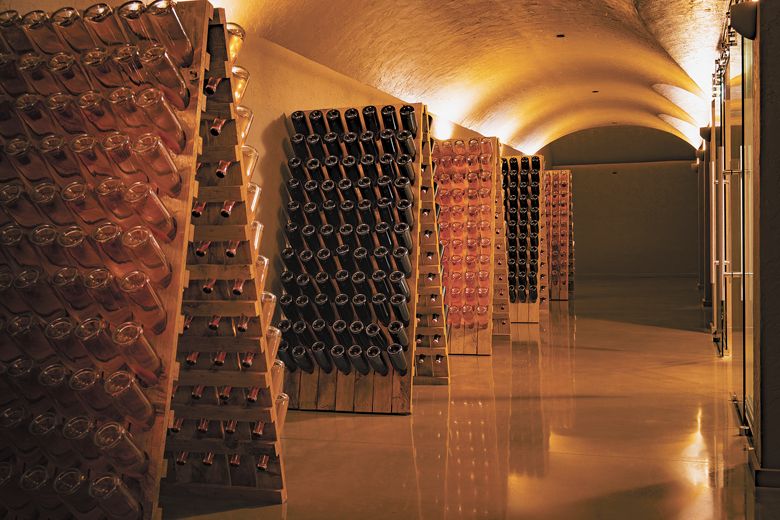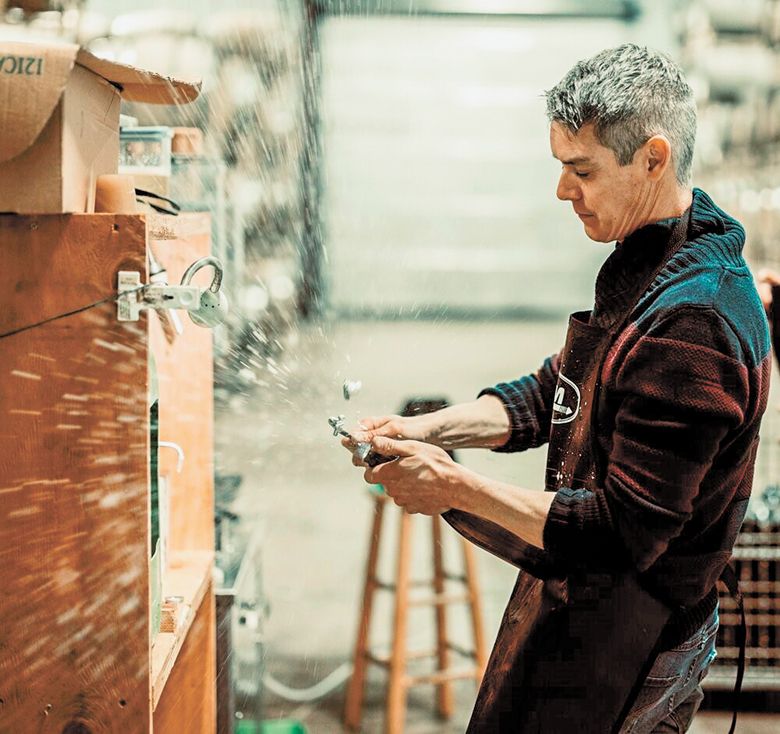Desire for Dosage
Winemakers with a passion for bubbles


By Patty Mamula
Until recently, few wineries in Oregon made sparkling wine. About ten years ago, several people– individually and collectively– recognized its enormous potential in the Willamette Valley. The delicate grape varietals, cooler climate, sustainable farming practices and collaborative culture combined for a bubbly opportunity. Some of their stories follow.
Andrew Davis worked a decade at well-known sparkling producer Argyle Winery. He experienced the increased interest first hand. Although he received repeated requests for help making sparkling, “we couldn’t provide that assistance. We didn’t have the space, time or capacity,” he said.
When he left Argyle, “I knew my next step would be in sparkling,” he said. “I saw that Oregon and the Willamette Valley could make incredible bubbles.”
With demand for his technical assistance and skill, Davis purchased the necessary specialized machinery for a complete packaged service, launching Radiant Sparking Wine Company in 2014. He began with eight clients. Today, Davis has 43 with annual production topping 36,000 cases. “We’ve doubled the sparkling wine in Oregon. I’m not taking new clients because we’ve reached capacity with the equipment,” he said.
What Davis enjoys most about sparkling, aside from capitalizing on his production knowledge, is its complexity. “I like the challenge. It appeals to my curiosity. It’s joyful. Have you ever seen anyone not happy while drinking sparkling? I’ve been doing this for 20 years and continue to learn,” he said.
Davis’ sparkling signature lies in not having one. “I want all our clients to be successful. For each winery to have its own distinctive taste. That means getting out of the way when it comes to style,” explains Davis.
Bobby Rowett became Davis’ first assistant at Radiant. His wine journey began in Boise while working as a sommelier for a champagne importer. “I decided I’d rather be in production, not retail,” he admits.
After working harvest in Southern France, he moved to an Australian winery. “My boss owned a sparkling winery in Tasmania, so I gained more experience with bubbles, tasting and talking with people who make it,” said Rowett.
He determined Willamette Valley was perfect for wine, initially working at Goodfellow Family Cellars where he learned about the unique characteristics within various appellations. In 2013, he bought fruit from Whistling Ridge Vineyard and produced 50 cases of sparkling rosé under his own label, Mellen Meyer Sparkling Wine.
“It turned out great. I enjoyed the process and bought more fruit the following year,” he said. Simultaneously, Rowett learning premier sparkling practices, including dosage trials, at Radiant. Dosage is added after the temporary crown caps are removed, the yeast plugs expelled and bottles are topped up. With dosage trials, winemakers experiment with various levels of sugar to achieve the desired balance.
After aging nearly three years, Rowett sold all his wine to a single buyer and gained the confidence to increase production, currently making 1000 cases annually.
“Since I first started, sparkling was my favorite type of wine. I was inspired early on,” explained Rowett. “My sparkling style highlights fruit flavors with low dosage. My wines are bright, best aged and enjoyed with food,” he said.
Back at Argyle Winery, winemaker Nate Klostermann first started as a harvest intern in 2005. “I was very green after moving from Minnesota with a food science degree,” Klostermann said. After harvest, he worked full time in the lab and cellar. “It was a great hands-on experience,” he recalls. “We were disgorging bottles from 1999. It was exciting to see what happens over time.”
Disgorging (removing the spent lees and yeast plug) occurs before bottles are finished with a cork and wire cage. “I fell in love with the process— making the base wine, performing the dosage trials, disgorging. I enjoy the evolution, the life cycle. We’re currently doing extended tirages on wines that have been aging since 1995 and 1996,” he said.
Both he and Davis trained under Rollin Soles, who left Argyle in 2012 to focus on his own brand, ROCO Winery. Kolstermann feels fortunate to have worked with Soles. “He taught structure and rules. I learned the intricacies of sparkling, a long, slow process. It keeps me engaged. There’s something to be done year-round. It’s a wine of subtlety. What happened five years ago can take time to develop,” said Kolstermann.
Every year, Argyle produces 40,000 cases of sparkling and the smaller, single vineyard bottlings are often selected for extended aging. Has he mastered the process? Klostermann replied, “ No, never. There’s always something new– positive and negative.”
One of the newer sparkling labels, Corollary Wines, was started by Jeanne Feldkamp and Dan Diephouse, a couple whose interest in sipping sparkling wines bubbled into making it. Diephouse worked from home in Grand Rapids, Michigan. “A nearby wine bar became my second home as an escape from my apartment,” he said. He and the owner began exploring Champagne. “I fell in love with bubbles. French grower-producer sparkling was widely available, and Terry Theise, a well-known importer, wrote lengthy catalogs filled with in-depth stories about the people and places behind the Champagne labels,” he said. “We drank our way through his collections.”
In 2008, Diephouse met Feldkamp during a work trip and soon afterward moved to San Francisco. They shared a love for food, wine and cocktails. Feldkamp was raised in Beaverton by a mother who strongly believed in the singular connection between food and farms. “I grew up in a household appreciating the link between our food and wine and what we ate and drank,” she said.
The couple started a supper club, hosting monthly six-course dinners with wine pairings. “We had an email list of friends and family that just keep growing. We sold tickets and limited each dinner to 12 people, an ideal number for conversation,” said Feldkamp. “It was a trend in San Francisco at the time,” added Diephouse.
They spent hours tasting different wines, particularly sparkling. “I began bringing Dan to explore our wine community,” said Feldkamp. They soon discovered few wineries making sparkling.
“We started mulling over the idea of making wine,” said Feldkamp.
Initially, they made a sparkling cider and it turned out well. That success prompted a foray into sparkling wine. “We spent 6 p.m. to 2 a.m. on the wine, working our tech jobs during the day,” she said. The laborious process yielded 100 cases.
Things began to snowball the next year as they researched vineyards, searching for potential sources. “We discovered a welcoming, open winemaking community and met many people excited about sparkling.” They moved to Newberg in 2017, and Davis at Radiant connected them to Winter’s Hill, where they made 500 cases.
Since their first commercial vintage, they have crafted a Cuvée One that spends 30 months on tirage. Each year, they hold some over for an extended tirage of 60 months or longer. “With that extra time, the lees from the secondary fermentation break down, adding texture and developing a toasty, brioche flavor,” said Feldkamp.
In July 2022, they bought 57 acres. “We never planned to buy or have a vineyard, but Jessica Cortell at Vitis Terra told us about the land. It was a 40-year-old timber farm situated on top of the Eola Amity Hills where volcanic soil meets sedimentary at 700 feet elevation,” said Felddkamp. “We were excited the property had never had chemicals applied,” said Diephouse. Last fall, they planted 12 acres— Pinot Noir, Chardonnay, Pinot Meunier and Pinot Blanc.
The term corollary means the truth of one thing can be based on the truth of another thing. “If we select the right site and farm ethically, the corollary is the wine will be good,” said Feldkamp. Focused exclusively on bubbles, they envision a future where the Willamette Valley becomes so well known for its sparkling it will attract people from all over the world.
Similarly, Domaine Willamette, a Willamette Valley Vineyards project, also anticipates a bright future. “We’re blessed in Oregon to have this weather. We can make some gorgeous sparkling with beautiful Pinot Noir fruit,” explains head winemaker Terry Culton. “We made our first vintage of sparkling in 2018. It was a new process for us and Radiant helped quite a bit,”
Culton worked at Willamette Valley Vineyards in the ’90s before moving to California to gain experience making single vineyard wines at Calera Winery. In 2022, Willamette Valley Vineyards founder Jim Bernau asked him to come back. “I always planned to return. It’s amazing how 20 years go by in a blink of an eye,” he said.
“Our goal is to make top-tier sparkling. We started small and are working toward extended tirages of 5 to 10 years,” said Culton. Producing a mere 500 to 1,000 cases, they plan to expand to 5,000, at which point they will purchase their own equipment. In the meantime, Radiant manages the riddling and disgorging. “We love working with Davis,” said Culton.
“From a winemaker’s standpoint, sparkling is very exciting. Every bottle is its own little fermenter,” he said. “It’s also challenging to stay patient while waiting to try the final product. But that leads to the rewarding part— sitting down years later and enjoying it, recalling the vintage and weather.”
Perhaps the most notable sparkling producer outside of the Willamette Valley is Del Rio’s French winemaker Jean-Michel Jussiaume. Each year, he makes limited quantities of the highly rated Maison Jussiaume, producing a Blanc de Blanc and a rosé.
Originally from the Loire Valley, he fondly recalls a white Muscadet wine his family makes using Melon de Bourgogne grapes. “I wanted to start my own wine label and offer something that reminded me of my home and Muscadet. But Melon de Bourgogne grapes don’t grow in the Rogue Valley,” he said.
He decided sparkling wine was a way to honor his family roots with locally-grown Chardonnay and Pinot Noir grapes. “It has to be fresh and lively. That’s my imprint. However, the weather is warmer here so no one was making sparkling,” he said.
Jussiaume produced his first vintage in 2015, entirely by hand. “It sounds crazy,” he said. When the juice finished fermentation, he tasted the base wine. It immediately transported him to tasting base wines in France– and confirmed it would make an excellent sparkling.
He prefers the labor-intensive approach. “With sparkling wine, you learn by doing. Everything influences the quality. Some bottles are easier to disgorge than others. If a bottle has a lot of foam, it means something. I would be missing out on the process if I was not involved in every step,” he said. He even hand riddles the bottles, turning them twice a day for three weeks in preparation for disgorging.
For Jussiaume and the others, the process of making Méthode Champenoise sparkling is truly a labor of love.












